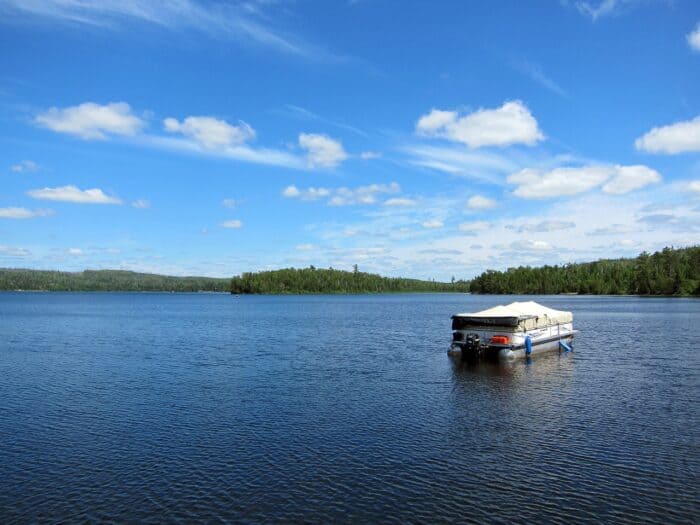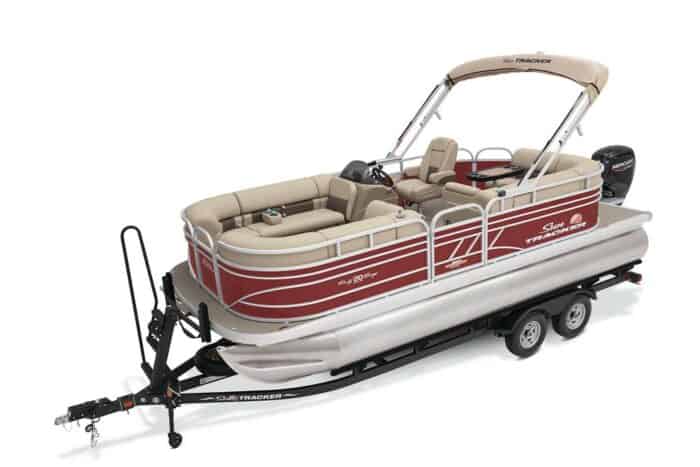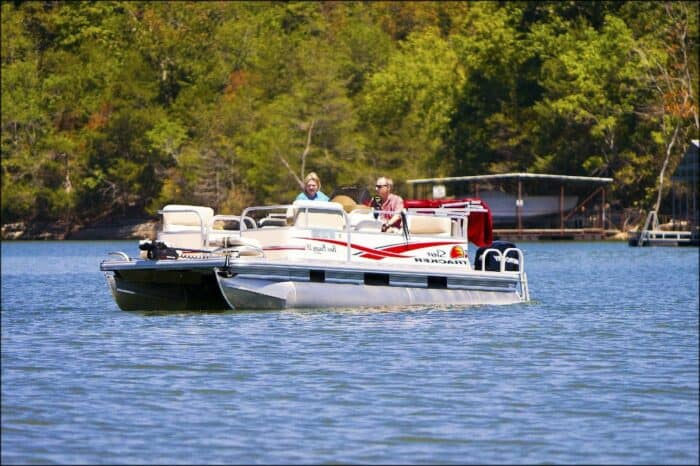Pontoon Boat Fuel Tank Location
One of the things many new pontoon boaters are not aware of is that the fuel tank in a pontoon boat can be located just about anywhere on the vessel. If you have a previously owned boat it’s possible the past owner tweaked its design and adjusted the weight balancing which could end up with a fuel tank in even the most unexpected places. I’ve seen pontoons with small fuel tanks just sitting on the deck, so it’s really a mixed bag of possibilities. In most cases with a typical pontoon boat you can expect to the fuel tank located in the transom, but that is not every pontoon boat by any means, and may definitely not be the case with older pontoons.
General Rules About the Gas Tank on Pontoon Boats
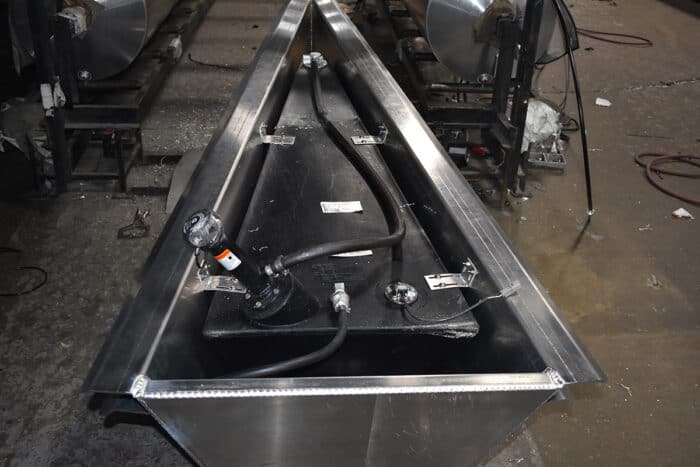
Typically your fuel tank is not going to be just sitting on deck, so that’s not often a concern. Pontoon fuel tanks can range in size from as small as 10 gallons to as much as 40 gallons in most boats. When you push it to extremes you can find small pontoons that may only hold 5 or 6 gallons of fuel. And then much larger pontoons that can hold 50 to 60 gallons or more. That would only be feasible on an extremely large boat, of course, as that would add an exceptional amount of weight to any pontoon. A gallon of fuel weighs about 6 lbs, so a 50 gallon tank would add another 300 lbs to your overall boat weight.
The size of your pontoon boat and its fuel tank can obviously have a big impact on the location of the tank itself. Smaller tanks are much easier to store in various places and the larger the tank is, the more space will be needed to house it.
Why Are So Many Tanks So Small?
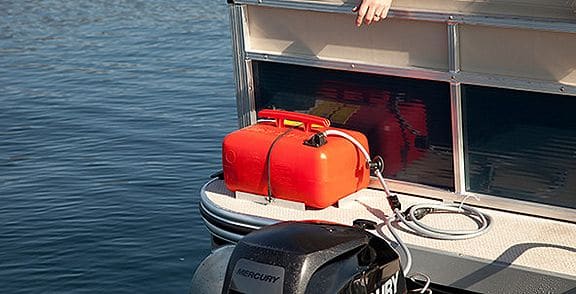
There are three reasons that many pontoon manufacturers use smaller fuel tanks than you might expect for boats of their size.
Multiple Tanks: You might find a pontoon that has two 6-gallon tanks to give you a full 12 gallons or some similar breakdown. This can happen because it may be easier to find room in the boat’s design for two small tanks rather than one larger one. If there’s room at the stern or below the passenger benches, for instance, you can find room for two tanks a little more easily, especially in small boats.
Fuel Efficiency: Pontoon boats are usually more efficient when it comes to fuel consumption compared to similarly sized boats. As a result, some manufacturers choose to limit the size of their fuel tanks because you’ll be making better use of the fuel overall. In general, a pontoon boat uses about 5 or 6 gallons of fuel per hour at cruising speed. So a 6-gallon tank will obviously not get you far but a 20 gallon tank could go a long way for many pontoon boat users.
Boat Use: Pontoons are not boats you’re going to use out on the open ocean. They’re generally only seeing use inland on lakes and that means they tend to never be far from shore. Because you many boats are expected to remain on a small lake, pontoon manufacturers will often lean towards smaller fuel tank sizes based on the idea that you don’t need the excess in the first place. This doesn’t reflect every pontoon, of course, but it does account for why some models, especially some of the smaller, more bare bones and basic models may have smaller tanks than you might expect. Because of this smaller size, again, there are more places in which a fuel tank can be located.
Common Fuel Tank Locations
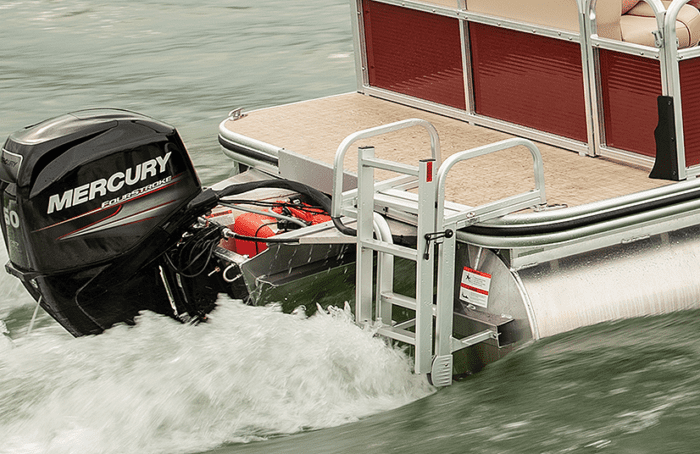
There is no industry standard for where to find a fuel tank on a pontoon boat. That said, here are some of the more common places you’re likely to find one when you need to.
Transom
Manufacturers like Bentley will have a standard fuel tank mounted inside the transom of their boats. A 32-gallon tank is a pretty common size for many Bentley models. The transom offers plenty of space to hold a tank of that size out of the way, but it does add that extra weight at the back that needs to be accounted for when you’re balancing your boat.
The transom mount is pretty standard for most modern boats that have an outboard motor. For smaller thanks, the transom will likely be broken down into segments or pods. For weight balancing, the central pod is often where a fuel tank will be located, but if there’s something balancing it out then you may find it to one side or the other. Only the larger fuel tanks will take up the transom across the entire width of the boat.
Fuel Tank Tray
Smaller tanks, like those 6-gallon ones, may be mounted at the rear of the boat near the outboard on a fuel tank tray. These small, portable tanks are pretty easy to install and remove so using a tank tray to secure them works. Obviously this wouldn’t be ideal for a large 32-gallon tank. You can easily see this type of tank on a boat as it makes use of the red portable fuel tank that we’re all familiar with.
These trays may be to the left or the right of the outboard, on top of the transom or even extending out from the transom over the water. In order to be used properly the tank needs to be well secured on the tray but, because they are portable, they can be easily removed as well. On some models the tank can be located in between the transom of the boat and the outboard itself.
Under Deck
Much like a fuel tank built into the transom, some pontoons will have fuel tanks built into custom cases located under the deck. These are generally located between the two pontoons and will be centrally located to account for the weight added. So, depending on how your boat is designed, you can be standing or sitting on it when you’re operating the vessel. Because of issues with drag, these need to be fitted in a proper case and well-sealed. Some boaters still prefer the transom mount to ensure their pontoon has clearance and less drag overall.
Under deck fuel tanks are best balanced along the beam of the boat but, depending on overall design, they may run along the center line and be located closer to the bow or the stern depending on a number of other factors.
Center Line Parallel
If you have a tritoon boat, you may find a pair of long, narrow tanks mounted parallel to the center line on either side of the center tube. This allows for balance when you have a tritoon which limits the under deck space in which a fuel tank could be mounted.
Center Tube
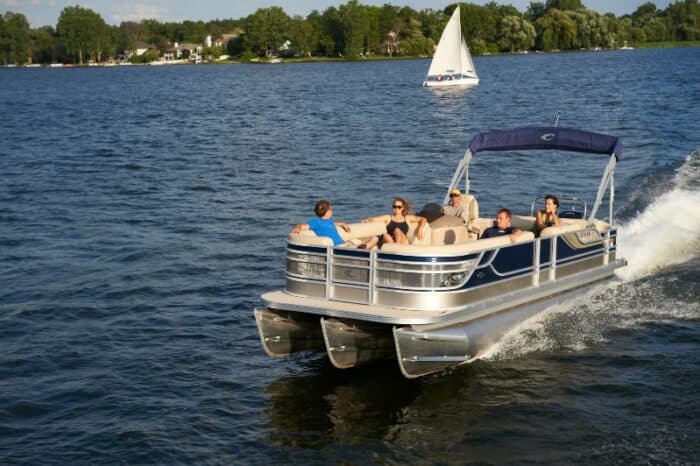
If you have a pontoon with a center tube, or a tritoon boat, you may have a fuel tank inside the center tube itself, as well as some storage you can use for the rest of the boat. Many pontoon boats with a third tube offer this feature. Depending on the size of your boat you may be able to add on the extra pontoon tube for somewhere between $1000 and $2000. The tube itself can add from 15 gallons to as much as 50 gallons of fuel capacity and potentially more, so you’ll need to check with the manufacturer to find out for sure. This can make a huge difference in overall fuel capacity
Deck Mounted
I mentioned above that I’ve seen a pontoon with a custom rig that had the fuel tank sitting in the open on deck. That’s weird, and probably a safety hazard, but there are also cases where a small tank can still be deck mounted, it just needs to be out of the way. Some pontoon manufacturers make use of the natural features on the deck of your boat to hide the tank, like under the console seat, under benches, at the base of storage areas and so on. Any of the places that can work as normal storage for your gear can be reserved for storing a fuel tank on the deck but out of general view. This is one of the times when two or more smaller tanks seems to work best, because you can make better use of those small storage spaces to hide them.
The Bottom Line
Fuel tanks on most pontoon boats can turn up in a variety of locations. Most pontoons, especially modern pontoon boats, make use of transom fuel tanks but that’s not always the case. Boats with a third tube may have a large tank stored in the center pontoon that can nearly double a boat’s fuel capacity compared to a transom mount depending on the fuel system.
Smaller fuel tanks may be located on fuel tank trays at the rear of the boat near the outboard itself. You may also find them under consoles and seating on the deck itself.
Finally, some pontoon boats may make use of under deck fuel tank storage. These can run parallel to the pontoons or perpendicular across the deck, typically somewhere centrally located so that the weight distribution remains even.
Categories: Pontoon Boats
